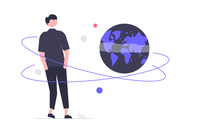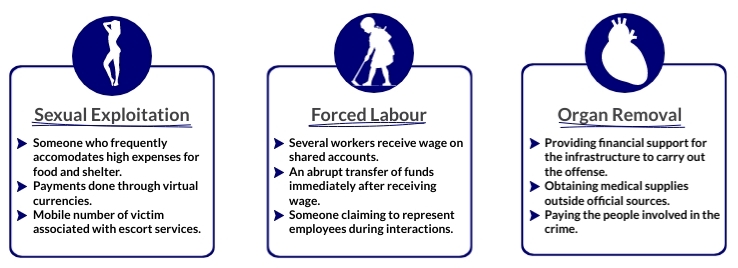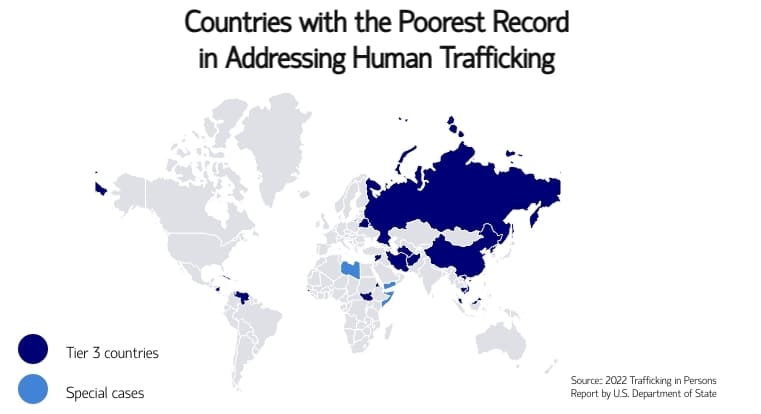It is estimated that human trafficking generates a worldwide profit of $29.4 billion with approximately 27.6 million people lacking the freedom to choose how they live and work, as reported by the International Labour Organization (ILO), the International Organization for Migration (IOM), and Walk Free.

This article embarks on a journey to explore the sinister nexus between human trafficking and money laundering, bringing to light the hidden mechanisms that fuel these illegal activities and examining ways to unmask and bring the culprits to justice.
What is human trafficking?
Human trafficking refers to the act of recruiting, transporting, transferring, harboring, or receiving people using force, fraud, or deception for the purpose of exploiting them for profit. This crime affects individuals of all ages, genders, and backgrounds, and it occurs in various regions around the world. Traffickers frequently resort to violence or fraudulent employment agencies, and they may make false promises of education and job opportunities to lure and coerce their victims.Human trafficking is a clandestine crime, often facilitated by language barriers, fear of traffickers, and/or fear of law enforcement, which can prevent victims from seeking help. Traffickers seek out vulnerable individuals for various reasons, such as economic hardship, psychological or emotional vulnerability, a lack of social safety net, natural disasters, and political instability.
According to the 2018 FATF report, there are three primary categories of human trafficking:
What is the link between money laundering and human trafficking?
The practice of human trafficking poses a serious risk to the rule of law and jeopardizes the safety and security of individuals globally. Not only is it an egregious violation of human rights, but it's also estimated to be one of the most lucrative crimes worldwide. In fact, the U.S. National Strategy for Combating Terrorist and Other Illicit Financing by the Treasury in 2020 recognized money laundering associated with human trafficking as a significant threat to illicit finance in the United States.
What kind of techniques do human traffickers use to launder money?
Human traffickers in the banking sector engage in money laundering through various tactics. They commonly aid trafficked individuals in opening bank accounts and acquiring pre-paid cards. To move significant amounts of cash, they use banks and money transfer services. They also accompany victims to financial institutions to structure deposits just below the threshold that would not prompt an investigation by the financial institution, thus avoiding detection.
In April 2023, Romanian and Irish law enforcement authorities, with support from Eurojust, took down a Romanian human trafficking ring that operated in Ireland. It was discovered that the the criminals laundered the proceeds of the sexual exploitation of their victims through fast money transfer services, bank accounts opened in the names of intermediaries, and real estate companies set up in Romania.
In the report "Laundering of proceeds from human trafficking for sexual exploitation," the Financial Transactions and Reports Analysis Centre of Canada (FINTRAC) also noted that criminals often launder their ill-gotten gains from human trafficking through online and physical casinos, virtual currencies, pre-paid credit cards, gift cards, and investment accounts.
Another common approach adopted by human traffickers is the use of shell companies to hide illicit gains, especially from massage parlors. This technique is often used due to the secrecy surrounding beneficial owners and the ease with which such companies can be established. These empty shells serve as a means to temporarily hold funds and gain entry to the financial system, enabling illegal profits to eventually leave the country through wire transfers and other banking transactions.
How can financial institutions disrupt human trafficking?
Financial institutions play a pivotal role in disrupting the illegal flow of money deriving from human trafficking. Not only are they the first line of defense against criminals wanting to launder or spend their ill-gotten gains, but they also help to report human traffickers and the flow of their finances to authorities and FIUs.Recognizable red flags in the banking industry include:
-
Surveillance of victims: customers are accompanied by an individual who makes decisions in their place and don’t allow them to talk to bank employees. This individual often has little relation to them.
Multi-accounting: individuals having multiple accounts in their name and often transfer money to other individuals to whom they have no relation.
Cash transactions: frequent deposits of cash or frequent cash transactions.
AML experts can keep track of these red flags by executing the following actions:
-
Identifying the customer and all proxys or people they are accompanied by.
Verifying the legitimacy of the received documents.
Monitoring transactions of the clients, especially if the client is a business with a high risk of being involved in human trafficking.
Having all business that are of high risk of human trafficking elevated to high-risk customers.
What legislation helps counter money laundering from human trafficking?
The Trafficking Victims Protection Act of 2000 (TVPA) provides the U.S. Government with fresh resources and strategies to eradicate contemporary types of slavery within the country and across borders. The TVPA bolstered safeguards for victims of trafficking in the United States, established protective measures for foreign nationals who are victims of human trafficking, and enhanced the U.S. government's endeavors to prevent trafficking.
In the EU, the 6th AMLD establishes a list of 22 predicate offenses that all EU Member States must consider when enforcing anti-money laundering measures, and which include human trafficking. By identifying and targeting the financial flows associated with human trafficking and other serious crimes, the 6th AMLD seeks to disrupt criminal networks and prevent the exploitation of vulnerable individuals.

The Modern Slavery Act 2015 is a UK law aimed at preventing modern slavery, including forced labour and human trafficking. The Act requires businesses operating in the UK with a turnover of £36 million or more to produce an annual statement outlining the steps they have taken to identify and prevent modern slavery in their operations and supply chains. The Act also introduced tougher penalties for those involved in modern slavery offenses and established the role of the Independent Anti-Slavery Commissioner to lead efforts to tackle modern slavery in the UK. The Act has been praised for its innovative approach to combating modern slavery and has influenced similar legislation in other countries.
What is the future of AML and human trafficking?
The EU has launched its four-year strategy on combating human trafficking in 2021. Priorities include breaking the business model of traffickers, both online and offline, by working with tech firms to reduce their access to platforms such as e-commerce and banks. The EU has provided €13 million in funding to achieve the full implementation of these goals.
The future of AML in human trafficking will likely involve the development of more sophisticated and technology-driven approaches that can detect and track financial transactions related to human trafficking, such as digital identity verification software and the use of advanced blockchain technology. AI and machine learning can be used to assess a customer's spending patterns across multiple variables over a dynamic period instead of relying on a static transaction threshold.
The fight against human trafficking is a critical issue, and AML can play a vital role in preventing and disrupting the financial flows that support this illicit trade.





